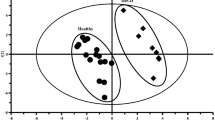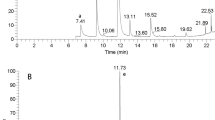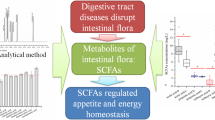Abstract
In the present study, the use of gas chromatography mass spectrometry (GC–MS)-based metabonomics to characterize blood serum in an intervention study of patients suffering from the common gastrointestinal disorder irritable bowel syndrome (IBS) was investigated. The patients included in the study consumed an acidified milk product with (n = 30) or without probiotics (n = 31) (Lactobacillus paracasei F19, Lactobacillus acidophilus LA-5 and Bifidobacterium lactis BB-12) for an 8-week period, and blood serum samples were collected before and after the intervention. Acidified milk is commonly used as a delivering vector for probiotics in commercial consumer settings. The serum samples were extracted and derivatized using N-Methyl-N-(trimethylsilyl) trifluoroacetamide (MSTFA), and GC–MS analysis was carried out. Multivariate data analysis including principal component analysis (PCA), orthogonal partial least squares-discriminant analysis (OPLS-DA), and S-plot was applied on the obtained GC–MS data, which revealed higher serum lactate, glutamine, proline creatinine/creatine, and aspartic acid levels and lower serum glucose levels after the intervention period for both treatment groups. Consequently, the present study indicated an effect of acidified milk consumption on the plasma metabolite profile, which was independent of a concomitant intake of probiotics. In addition, the present study demonstrates that GC–MS is a useful analytical technique for metabonomics studies of blood serum.



Similar content being viewed by others
References
Nicholson JK, Lindon JC, Holmes E (1999) ‘Metabonomics’: understanding the metabolic responses of living systems to pathophysiological stimuli via multivariate statistical analysis of biological NMR spectroscopic data. Xenobiotica 29(11):1181–1189
Xiayan L, Legido-Quigley C (2008) Advances in separation science applied to metabonomics. Electrophoresis 29(18):3724–3736
Weljie AM, Dowlatabadi R, Miller BJ, Vogel HJ, Jirik FR (2007) An inflammatory arthritis-associated metabolite biomarker pattern revealed by 1H NMR spectroscopy. J Proteome Res 6(9):3456–3464
Malmendal A, Overgaard J, Bundy JG, Sorensen JG, Nielsen NC, Loeschcke V, Holmstrup M (2006) Metabolomic profiling of heat stress: hardening and recovery of homeostasis in Drosophila. Am J Physiol Regul Integr Comp Physiol 291(1):R205–R212
Pedersen KS, Kristensen TN, Loeschcke V, Petersen BO, Duus JO, Nielsen NC, Malmendal A (2008) Metabolomic signatures of inbreeding at benign and stressful temperatures in Drosophila melanogaster. Genetics 180(2):1233–1243
Janis MT, Laaksonen R, Oresic M (2008) Metabolomic strategies to identify tissue-specific effects of cardiovascular drugs. Expert Opin Drug Metab Toxicol 4(6):665–680
Hines A, Oladiran GS, Bignell JP, Stentiford GD, Viant MR (2007) Direct sampling of organisms from the field and knowledge of their phenotype: key recommendations for environmental metabolomics. Environ Sci Technol 41(9):3375–3381
Bertram HC, Hoppe C, Petersen BO, Duus JO, Molgaard C, Michaelsen KF (2007) An NMR-based metabonomic investigation on effects of milk and meat protein diets given to 8-year-old boys. Br J Nutr 97(4):758–763
Bertram HC, Duarte IF, Gil AM, Knudsen KE, Laerke HN (2007) Metabolic profiling of liver from hypercholesterolemic pigs fed rye or wheat fiber and from normal pigs. High-resolution magic angle spinning 1H NMR spectroscopic study. Anal Chem 79(1):168–175
Bertram HC, Bach Knudsen KE, Serena A, Malmendal A, Nielsen NC, Frette XC, Andersen HJ (2006) NMR-based metabonomic studies reveal changes in the biochemical profile of plasma and urine from pigs fed high-fibre rye bread. Br J Nutr 95(5):955–962
Lenz EM, Wilson ID (2007) Analytical strategies in metabonomics. J Proteome Res 6(2):443–458
Jiye A, Trygg J, Gullberg J, Johansson AI, Jonsson P, Antti H, Marklund SL, Moritz T (2005) Extraction and GC/MS analysis of the human blood plasma metabolome. Anal Chem 77(24):8086–8094
Pasikanti KK, Ho PC, Chan EC (2008) Gas chromatography/mass spectrometry in metabolic profiling of biological fluids. J Chromatogr B Analyt Technol Biomed Life Sci 871(2):202–211
Qiu Y, Su M, Liu Y, Chen M, Gu J, Zhang J, Jia W (2007) Application of ethyl chloroformate derivatization for gas chromatography-mass spectrometry based metabonomic profiling. Anal Chim Acta 583(2):277–283
Gionchetti P, Rizzello F, Helwig U, Venturi A, Lammers KM, Brigidi P, Vitali B, Poggioli G, Miglioli M, Campieri M (2003) Prophylaxis of pouchitis onset with probiotic therapy: a double-blind, placebo-controlled trial. Gastroenterology 124(5):1202–1209
Gosselink MP, Schouten WR, van Lieshout LM, Hop WC, Laman JD, Ruseler-van Embden JG (2004) Delay of the first onset of pouchitis by oral intake of the probiotic strain Lactobacillus rhamnosus GG. Dis Colon Rectum 47(6):876–884
Kajander K, Hatakka K, Poussa T, Farkkila M, Korpela R (2005) A probiotic mixture alleviates symptoms in irritable bowel syndrome patients: a controlled 6-month intervention. Aliment Pharmacol Ther 22(5):387–394
Kajander K, Myllyluoma E, Rajilic-Stojanovic M, Kyronpalo SS, Rasmussen M, Jarvenpaa SS, Zoetendal EG, de Vos WM, Vapaatalo H, Korpela R (2007) Clinical trial: multispecies probiotic supplementation alleviates the symptoms of IBS and stabilises intestinal microbiota. Aliment Pharmacol Ther 27(1):48–57
Kim HJ, Camilleri M, McKinzie S, Lempke MB, Burton DD, Thomforde GM, Zinsmeister AR (2003) A randomized controlled trial of a probiotic, VSL#3, on gut transit and symptoms in diarrhoea-predominant irritable bowel syndrome. Aliment Pharmacol Ther 17(7):895–904
Niedzielin K, Kordecki H, Birkenfeld B (2001) A controlled, double-blind, randomized study on the efficacy of Lactobacillus plantarum 299 V in patients with irritable bowel syndrome. Eur J Gastroenterol Hepatol 13(10):1143–1147
Akehurst R, Kaltenthaler E (2001) Treatment of irritable bowel syndrome: a review of randomised controlled trials. Gut 48(2):272–282
Drossman DA, Camilleri M, Mayer EA, Whitehead WE (2002) AGA technical review on irritable bowel syndrome. Gastroenterology 123(6):2108–2131
Foxx-Orenstein A (2006) IBS—review and what’s new. MedGenMed 8(3):20
Ersryd A, Posserud I, Abrahamsson H, Simren M (2007) Subtyping the irritable bowel syndrome by predominant bowel habit: Rome II versus Rome III. Aliment Pharmacol Ther 26(6):953–961
Francis CY, Morris J, Whorwell PJ (1997) The irritable bowel severity scoring system: a simple method of monitoring irritable bowel syndrome and its progress. Aliment Pharmacol Ther 11(2):395–402
Pedersen SMM, Nielsen NC, Andersen HJ, Olsson J, Simrén M, Ohman L, Svensson U, Malmendal A, Bertram HC (2010) The serum metabolite response to diet intervention with probiotic acidified milk in irritable bowel syndrome patients is indistinguishable from that of non-probiotic acidified milk by 1H NMR-based metabonomic analysis. Nutrients 2(11):1141–1155
Simren M, Ohman L, Olsson J, Svensson U, Ohlson K, Posserud I, Strid H (2010) Clinical trial: the effect of a fermented milk containing three probiotic bacteria in patients with irritable bowel syndrome (IBS)—a randomized, double-blind, controlled study. Aliment Pharmacol Ther 31(2):218–227
Trygg J, Wold S (2002) Orthogonal projections to latent structures (O-PLS). J Chemometr 16(3):119–128
Keun HC, Ebbels TMD, Antti H, Bollard ME, Beckonert O, Holmes E, Lindon JC, Nicholson JK (2003) Improved analysis of multivariate data by variable stability scaling: application to NMR-based metabolic profiling. Anal Chim Acta 490(1–2):265–276
Wiklund S, Johansson E, Sjostrom L, Mellerowicz EJ, Edlund U, Shockcor JP, Gottfries J, Moritz T, Trygg J (2008) Visualization of GC/TOF-MS-based metabolomics data for identification of biochemically interesting compounds using OPLS class models. Anal Chem 80(1):115–122
Wyss M, Kaddurah-Daouk R (2000) Creatine and creatinine metabolism. Physiol Rev 80(3):1107–1213
Enck P, Klosterhalfen S (2005) The placebo response in functional bowel disorders: perspectives and putative mechanisms. Neurogastroenterol Motil 17(3):325–331
Kreisberg RA (1980) Lactate homeostasis and lactic acidosis. Ann Intern Med 92(2 Pt 1):227–237
Pitz M, Cheang M, Bernstein CN (2005) Defining the predictors of the placebo response in irritable bowel syndrome. Clin Gastroenterol Hepatol 3(3):237–247
Hoveyda N, Heneghan C, Mahtani KR, Perera R, Roberts N, Glasziou P (2009) A systematic review and meta-analysis: probiotics in the treatment of irritable bowel syndrome. BMC Gastroenterol 9:15
Daly M (2003) Sugars, insulin sensitivity, and the postprandial state. Am J Clin Nutr 78(4):865S–872S
Daly ME, Vale C, Walker M, Littlefield A, Alberti KG, Mathers JC (1998) Acute effects on insulin sensitivity and diurnal metabolic profiles of a high-sucrose compared with a high-starch diet. Am J Clin Nutr 67(6):1186–1196
DeFronzo RA, Ferrannini E (1982) Influence of plasma glucose and insulin concentration on plasma glucose clearance in man. Diabetes 31(8 Pt 1):683–688
Schenk S, Davidson CJ, Zderic TW, Byerley LO, Coyle EF (2003) Different glycemic indexes of breakfast cereals are not due to glucose entry into blood but to glucose removal by tissue. Am J Clin Nutr 78(4):742–748
Ostman EM, Liljeberg Elmstahl HG, Bjorck IM (2001) Inconsistency between glycemic and insulinemic responses to regular and fermented milk products. Am J Clin Nutr 74(1):96–100
Watford M (2008) Glutamine metabolism and function in relation to proline synthesis and the safety of glutamine and proline supplementation. J Nutr 138(10):2003S–2007S
Bertolo RF, Brunton JA, Pencharz PB, Ball RO (2003) Arginine, ornithine, and proline interconversion is dependent on small intestinal metabolism in neonatal pigs. Am J Physiol Endocrinol Metab 284(5):E915–E922
Fujita T, Yanaga K (2007) Association between glutamine extraction and release of citrulline and glycine by the human small intestine. Life Sci 80(20):1846–1850
Burtscher M, Brunner F, Faulhaber M, Hotter B, Likar R (2005) The prolonged intake of l-arginine-l-aspartate reduces blood lactate accumulation and oxygen consumption during submaximal exercise. J Sports Sci Med 4(3):314–322
Lancha AH Jr, Recco MB, Abdalla DS, Curi R (1995) Effect of aspartate, asparagine, and carnitine supplementation in the diet on metabolism of skeletal muscle during a moderate exercise. Physiol Behav 57(2):367–371
Acknowledgments
We acknowledge The Danish Dairy Council for funding the project “A nutrigenomic approach in the elucidation of basic molecular mechanisms for the action of probiotic bacteria”. In addition, the authors acknowledge support from the Danish National Research Foundation, Arla Foods and the Interdisciplinary Nanoscience Center (iNANO) at Aarhus University.
Author information
Authors and Affiliations
Corresponding author
Rights and permissions
About this article
Cite this article
Pedersen, S.M.M., Nebel, C., Nielsen, N.C. et al. A GC–MS-based metabonomic investigation of blood serum from irritable bowel syndrome patients undergoing intervention with acidified milk products. Eur Food Res Technol 233, 1013–1021 (2011). https://doi.org/10.1007/s00217-011-1599-1
Received:
Revised:
Accepted:
Published:
Issue Date:
DOI: https://doi.org/10.1007/s00217-011-1599-1




